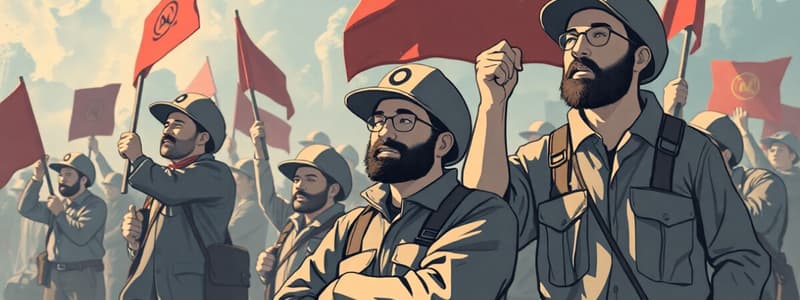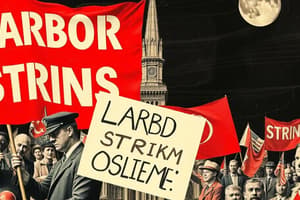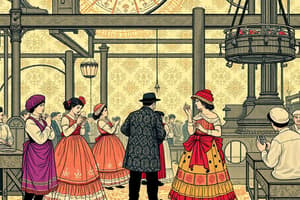Podcast
Questions and Answers
What was the primary reason behind unions becoming involved in social housing and community development in the early 1980s?
What was the primary reason behind unions becoming involved in social housing and community development in the early 1980s?
- To provide employment opportunities for their members.
- To invest their pension funds more effectively.
- To increase their political influence.
- To respond to the economic challenges of the recession. (correct)
Which of the following is NOT a common area of activity for Canadian unions?
Which of the following is NOT a common area of activity for Canadian unions?
- Collective bargaining
- Investment banking services (correct)
- Legislative and political lobbying
- Grievance handling
What is the primary purpose of Economically Targeted Investments (ETIs)?
What is the primary purpose of Economically Targeted Investments (ETIs)?
- To provide financial assistance to struggling businesses owned by union members.
- To generate higher returns for pension funds.
- To direct pension fund assets towards community development and affordable housing. (correct)
- To invest pension funds exclusively in socially responsible companies.
How have unions traditionally used their halls?
How have unions traditionally used their halls?
Which of the following is an example of how unions have expanded their educational offerings?
Which of the following is an example of how unions have expanded their educational offerings?
What is a primary reason for unions to engage in internal publicity efforts?
What is a primary reason for unions to engage in internal publicity efforts?
Which union has been particularly active in employee buyouts, even when other unions have been critical?
Which union has been particularly active in employee buyouts, even when other unions have been critical?
What is the main purpose of 'labour-sponsored venture capital corporations'?
What is the main purpose of 'labour-sponsored venture capital corporations'?
What is the main reason unions are often involved in political activity?
What is the main reason unions are often involved in political activity?
Which of the following is NOT a reason unions find it necessary to communicate with the public?
Which of the following is NOT a reason unions find it necessary to communicate with the public?
What is the main reason why some unions disagree with formal or informal affiliation with political parties?
What is the main reason why some unions disagree with formal or informal affiliation with political parties?
What does the text suggest is a potential drawback of unions forming strong alliances with political parties?
What does the text suggest is a potential drawback of unions forming strong alliances with political parties?
Which of the following is an example of a recent trend in union political activity?
Which of the following is an example of a recent trend in union political activity?
Why are public sector unions particularly reliant on external publicity campaigns?
Why are public sector unions particularly reliant on external publicity campaigns?
What is a key reason why unions recognize the necessity of external publicity efforts?
What is a key reason why unions recognize the necessity of external publicity efforts?
What common element do external publicity campaigns and member communication share in the context of unions?
What common element do external publicity campaigns and member communication share in the context of unions?
Which of these is NOT a factor that makes it difficult to determine the impact of unions on productivity?
Which of these is NOT a factor that makes it difficult to determine the impact of unions on productivity?
Which of the following is a way unions can positively impact productivity?
Which of the following is a way unions can positively impact productivity?
Which of these is NOT an example of a way unions can positively impact productivity according to the text?
Which of these is NOT an example of a way unions can positively impact productivity according to the text?
What is the primary way that unions limit the management's ability to run a business as they see fit?
What is the primary way that unions limit the management's ability to run a business as they see fit?
What is a key argument made by institutionalists regarding union impacts on productivity?
What is a key argument made by institutionalists regarding union impacts on productivity?
What is the main argument made by neoclassicists regarding the impact of unions on productivity?
What is the main argument made by neoclassicists regarding the impact of unions on productivity?
Which of these is an example of a way unions can improve the bargaining environment for workers?
Which of these is an example of a way unions can improve the bargaining environment for workers?
Which of these is NOT a factor that the text mentions as contributing to the difficulty in measuring the impact of unions on productivity?
Which of these is NOT a factor that the text mentions as contributing to the difficulty in measuring the impact of unions on productivity?
What is a significant barrier to integrative bargaining?
What is a significant barrier to integrative bargaining?
What is a potential consequence of unions participating in joint ventures with management?
What is a potential consequence of unions participating in joint ventures with management?
Which of the following is NOT an example of a joint venture between unions and management?
Which of the following is NOT an example of a joint venture between unions and management?
What is the primary focus of sectoral councils formed by unions and management?
What is the primary focus of sectoral councils formed by unions and management?
What is a potential challenge for unions participating in joint governance arrangements with management?
What is a potential challenge for unions participating in joint governance arrangements with management?
What is the Canadian Labour and Business Centre (CLBC) primarily involved in?
What is the Canadian Labour and Business Centre (CLBC) primarily involved in?
What does the phrase 'political action' typically refer to in the context of unions?
What does the phrase 'political action' typically refer to in the context of unions?
Why are joint governance schemes considered controversial within the labor movement?
Why are joint governance schemes considered controversial within the labor movement?
What is the primary reason why many workers join unions?
What is the primary reason why many workers join unions?
Which of the following is NOT an example of how unions have expanded their activities beyond traditional labor issues?
Which of the following is NOT an example of how unions have expanded their activities beyond traditional labor issues?
What is a significant financial strategy that many unions have adopted since the mid-1980s?
What is a significant financial strategy that many unions have adopted since the mid-1980s?
How has the scope of union education changed in recent times?
How has the scope of union education changed in recent times?
What is the approximate range of the direct wage impact (union premium) for workers in Canada?
What is the approximate range of the direct wage impact (union premium) for workers in Canada?
In which industry is the union wage premium generally the highest?
In which industry is the union wage premium generally the highest?
Which group of workers typically experiences a larger union wage premium?
Which group of workers typically experiences a larger union wage premium?
What is the general trend regarding the scope of union action in the 21st century?
What is the general trend regarding the scope of union action in the 21st century?
What is the potential negative effect of a collective agreement on an organization?
What is the potential negative effect of a collective agreement on an organization?
Which of the following is NOT a positive impact of unions on society as a whole, according to the text?
Which of the following is NOT a positive impact of unions on society as a whole, according to the text?
What is the main method unions apply to achieve their positive impacts on Canadian society?
What is the main method unions apply to achieve their positive impacts on Canadian society?
How does the text suggest determining whether the positive or negative effects of a collective agreement are more prevalent?
How does the text suggest determining whether the positive or negative effects of a collective agreement are more prevalent?
What is the main argument against the continued need for unions in the modern workplace?
What is the main argument against the continued need for unions in the modern workplace?
Which of the following is NOT mentioned as a way unions have contributed to a better Canada?
Which of the following is NOT mentioned as a way unions have contributed to a better Canada?
What is the relationship between free trade unions and democracy?
What is the relationship between free trade unions and democracy?
Which of the following best describes the author's overall stance on the value of unions in today's society?
Which of the following best describes the author's overall stance on the value of unions in today's society?
Flashcards
Integrative Bargaining
Integrative Bargaining
A negotiation strategy focusing on mutual gains for both parties.
Joint Ventures
Joint Ventures
Collaborative projects between unions and management to enhance workplace conditions.
Scanlon Plan
Scanlon Plan
A broad gainsharing plan that encourages productivity and morale in the workplace.
Quality Circles
Quality Circles
Signup and view all the flashcards
Self-Directed Work Teams
Self-Directed Work Teams
Signup and view all the flashcards
Joint Governance
Joint Governance
Signup and view all the flashcards
Sectoral Councils
Sectoral Councils
Signup and view all the flashcards
Political Action
Political Action
Signup and view all the flashcards
Internal Publicity
Internal Publicity
Signup and view all the flashcards
Labour-sponsored Venture Capital
Labour-sponsored Venture Capital
Signup and view all the flashcards
Quebec Solidarity Fund
Quebec Solidarity Fund
Signup and view all the flashcards
Economically Targeted Investment (ETI)
Economically Targeted Investment (ETI)
Signup and view all the flashcards
Employee Buyouts
Employee Buyouts
Signup and view all the flashcards
Union Education
Union Education
Signup and view all the flashcards
Health and Safety Courses
Health and Safety Courses
Signup and view all the flashcards
Expanded Scope of Action
Expanded Scope of Action
Signup and view all the flashcards
Political Involvement of Unions
Political Involvement of Unions
Signup and view all the flashcards
Affiliation with Political Parties
Affiliation with Political Parties
Signup and view all the flashcards
Historical Links to NDP
Historical Links to NDP
Signup and view all the flashcards
Extra-Parliamentary Activity
Extra-Parliamentary Activity
Signup and view all the flashcards
Social Justice Fund
Social Justice Fund
Signup and view all the flashcards
Publicity Campaigns
Publicity Campaigns
Signup and view all the flashcards
Communication with Members
Communication with Members
Signup and view all the flashcards
Bargaining Rights
Bargaining Rights
Signup and view all the flashcards
Union Partnerships
Union Partnerships
Signup and view all the flashcards
International Development
International Development
Signup and view all the flashcards
Pension Fund Utilization
Pension Fund Utilization
Signup and view all the flashcards
Labour Education Expansion
Labour Education Expansion
Signup and view all the flashcards
Publicity Strategies
Publicity Strategies
Signup and view all the flashcards
Union Wage Impact
Union Wage Impact
Signup and view all the flashcards
Industry Variance
Industry Variance
Signup and view all the flashcards
Sector Differences
Sector Differences
Signup and view all the flashcards
Unions' role in labor legislation
Unions' role in labor legislation
Signup and view all the flashcards
Impact on productivity
Impact on productivity
Signup and view all the flashcards
Neoclassicist view on unions
Neoclassicist view on unions
Signup and view all the flashcards
Institutionalist view on unions
Institutionalist view on unions
Signup and view all the flashcards
Union grievance processes
Union grievance processes
Signup and view all the flashcards
Joint committees
Joint committees
Signup and view all the flashcards
Management limitations by unions
Management limitations by unions
Signup and view all the flashcards
Worker morale
Worker morale
Signup and view all the flashcards
Collective Agreement
Collective Agreement
Signup and view all the flashcards
Unionized Management
Unionized Management
Signup and view all the flashcards
Impact on Creativity
Impact on Creativity
Signup and view all the flashcards
Union Effects on Society
Union Effects on Society
Signup and view all the flashcards
Political Participation
Political Participation
Signup and view all the flashcards
Health and Safety Advocacy
Health and Safety Advocacy
Signup and view all the flashcards
Need for Unions Today
Need for Unions Today
Signup and view all the flashcards
Democracy and Free Trade Unions
Democracy and Free Trade Unions
Signup and view all the flashcards
Study Notes
Union Actions and Impacts
- Unions engage in various activities, including traditional collective bargaining and political action, and more modern approaches, such as venture capital corporations.
- Union activities impact wages, productivity, and organizational management, as well as broader societal effects.
- Collective bargaining remains a core activity, but its scope has expanded to include joint ventures, publicity campaigns, and other educational and business ventures.
- Strategies and technologies available to unions have evolved since their inception.
Collective Bargaining
- Wages and job security remain central concerns in collective bargaining.
- The range of issues has broadened over the past 100 years, including fringe benefits like pensions, vacation time, insurance, and provisions for maternity/paternity leave, flexible schedules, and anti-discrimination policies.
- Concerns for worker well-being are increasingly reflected in bargaining demands, including provisions for employee assistance programs for drug, alcohol or other personal problems.
- Integrative bargaining (problem-solving) is increasingly used rather than the traditional distributive (adversarial) style. This requires significant attitudinal changes from both unions and management.
Joint Union-Management Ventures
- Unions are increasingly participating in joint ventures with management, aimed at increasing morale and productivity.
- Joint ventures range from simple committees to broader gainsharing plans, employee stock ownership plans, and joint governance arrangements.
- While offering opportunities, these ventures raise concerns about a radical transformation of the union's role from workers' advocate to co-manager.
Joint Participation Outside the Workplace
- Unions engage in various joint ventures outside the workplace, including sectoral councils to address training, economic restructuring, trade policy, and labour-management cooperation on an industry-wide basis.
- Initiatives include the Canadian Labour and Business Centre (CLBC).
- Research is conducted on labour-related issues from work hours to women's changing roles in the workplace.
Political Action
- Most Canadian unions engage in some form of political action, which is often deemed inevitable for achieving union objectives.
- This includes influencing legislation and government policies.
- Internal debate exists on the most effective approaches to political participation.
Union Publicity Campaigns
- Unions actively engage in publicity campaigns directed at both members and the public.
- This ranges from informing the public about union activities to advocating for specific positions on public policy and expressing support for specific political parties.
- Internal publicity efforts are also needed to keep members informed about union activities and decisions, especially regarding controversial issues.
- Campaigns serve a variety of purposes, as described in the text.
Union Impacts on Productivity
- Evaluating the impact of unions on productivity is challenging, especially in sectors beyond goods production.
- Various models and arguments exist, including those that see unions as reducing productivity via higher wages or restrictive work rules.
- Some view unions as having positive impacts on productivity by promoting workplace equity, improving morale, and enabling better workplace cooperation.
Union Impacts on Management
- Unionization in a workplace introduces more structured and less chaotic environments.
- Unionization affects management's ability to act independently, demanding that formal rules and policies be followed.
- Unions are instrumental in improving personnel policies and providing wage and benefit structures.
Union Impacts on Society
- Unions have broadly positive impacts on society at a macro level.
- This includes supporting social programs, advocating for health and safety measures, promoting employment equity, and more.
- The presence of unions contributes to a more equitable and well-functioning society.
Continued Need for Unions
- Some argue that unions are no longer necessary in contemporary workplaces where workers are generally well-compensated and well-treated.
- Others emphasize that unions continue to be important for providing a counterbalance to powerful economic and political forces.
Studying That Suits You
Use AI to generate personalized quizzes and flashcards to suit your learning preferences.




